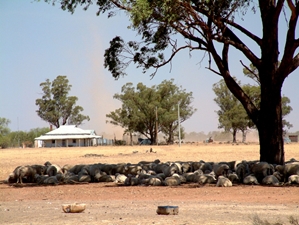
The conditions in Australia can fluctuate wildly, as many of you will know. Melbourne can see scorching heat, heavy rain and wild lightning all in a day, while parts of the outback can be as prone to flooding as they are to drought. Dealing with the extremely dry conditions that can plague parts of Australia is crucial for anyone with a regional or rural property, and part of that is the correct upkeep of your custom designed shed. Of course, your plans for taking care of yourself and your family should be in place first, but if you can, these practices are important to remember for many people with sheds.
Feeding livestock appropriately
When drought strikes, it can be that feed for your livestock is in short supply, meaning measures must be taken to keep these levels up and maintain the health of your animals. If you have a shed for horses, lucerne hay and grains are not always on hand in a period of drought. In this case, the New South Wales Department of Primary Industries has a number of alternative methods you can undertake.
If you make sure your horses get 0.5 to 0.7 per cent of their liveweight by consuming roughage, then you can use other combinations to make up the rest of their feed. This includes well-cured hay, and it is recommended to use pasture hay in some circumstances, while the legume variant can also be used at times. The general rule of thumb from the DPI is to use three bales of poorer quality hay in the place of two top quality bales.
Heat-treated wheat is another viable option, in volumes of up to four kilograms per day. However, make sure it contains some roughage. You may also need to add limestone and salt to some feeds, so check with your local authority for more details on how to feed your horses if that's how you use your barn.
Protect your land
One problem that can arise during a drought is losing land quality through livestock feeding too much on ground cover. According to the Victorian Department of Primary Industries, this can loosen the soil and increase the risk of your land losing crucial nutrients and topsoil. To minimise this, feeding your stock in a contained area is a recommended plan.
The Victorian DPI says such an area, for sheep at least, should be a permanent structure, in case of future droughts, and also for possible use as an ongoing feeding lot. Shade and shelter are required, as is access to clean water and a moderate slope. These could be facilitated by constructing a custom designed barn with Shed Boss, as you can see when you design your own shed in the Shed Boss App.
There are different minimum size requirements for different types of livestock. For example, the DPI believes one square metre per head of lamb is appropriate, up to 1.3 square metres per head of adult sheep.
Having the right allocation of water for your livestock is also important, lest you lose stock during a drought. Rain water tanks are an additional feature that can be added to a design in the Shed Boss App, and with the right treatment could be ideal for conserving water. On top of this, Shed Boss can organise permits to connect water systems to your shed, giving you even more options.
Dealing with a drought is never easy. You need to have a lot of planning in place, the right resources, and also the ability to know when you need to do the hard part and cull. A custom designed shed may be able to minimise damage to your stock and land – talk to Shed Boss about what might work for you.
